欧洲城堡ppt
- 格式:ppt
- 大小:3.94 MB
- 文档页数:12
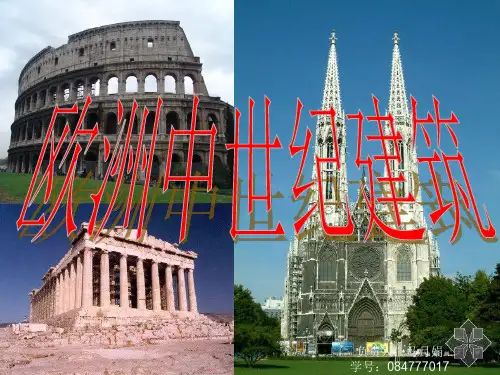



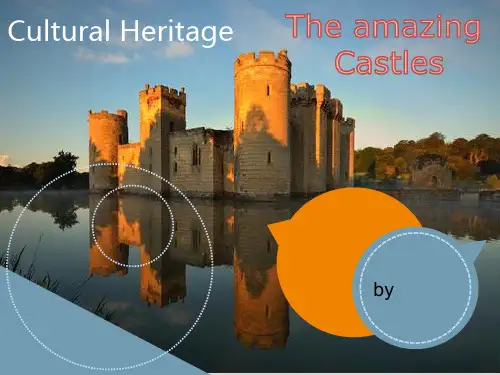
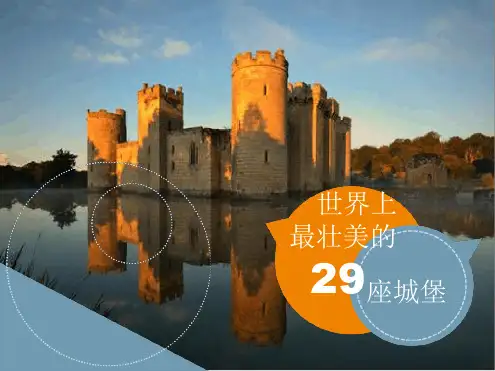
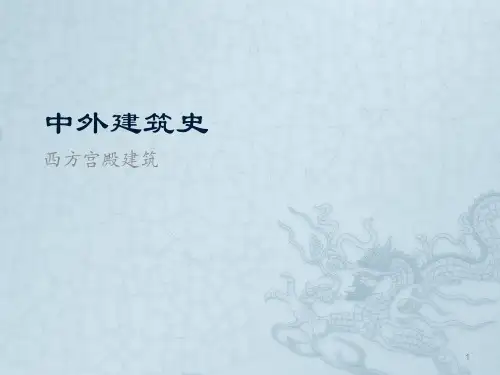
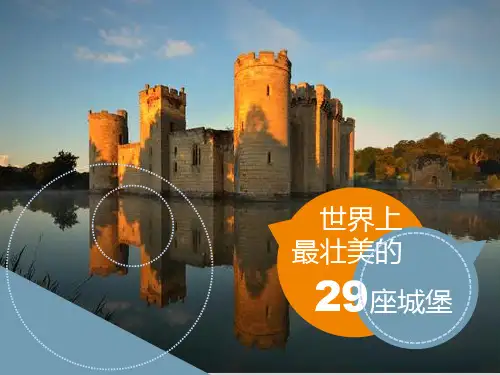



神游欧洲——欧洲城堡•喜欢旅游﹐喜欢照相﹐可是缺钱少闲﹐哪里也去不了﹐只能每天闷头干活挣柴米钱。
好在有一群好朋友经常发来一些好照片﹐了我心愿。
有了好事憋不住乐﹐拿出来与大家同享。
你若不差钱﹐有闲空﹐能够满世界游逛﹐这些照片不看也罢﹐实地观赏印象更深刻。
也可以与我一样﹐有心无力﹐不妨一起神游一趟﹐没吃过猪肉至少还见过猪跑﹐也不枉人世走一遭。
这几句话得贴在每篇的顶上﹐以免有人误以为这些照片是我拍的﹐岂不愧死我也。
•城堡是欧洲的一个特色。
•风格迥异的城堡星罗其布地分布在欧洲各地。
欧洲城堡的起源要追朔到中世纪。
当时欧洲各国国王都有一群支持他的骑士﹐国王依靠骑士看家护院﹐扩展疆土。
但是国王也不富裕﹐养不起这么一大帮闲人﹐就把自己的国土分封给骑士们﹐让他们自稚 珐o到打仗时再召集在一起。
骑士们为了保护自己的利益﹐就在分给自己的世袭领地里建起兼具生活和防御的堡垒。
从而给我们留下了这些因风俗﹐环境而各不相同的城堡。
•The Château de Chaumont is a French castle. It was the first château at Chaumont-sur-Loire, Loir-et-Cher, France. It was built by Eudes II, Count of Blois, in the 10th century with the purpose of serving as a fortress to protect Blois from attacks.•The Château de Chenonceau is a castle near the small village of Chenonceaux, in the Indre-et-Loire département of the Loire Valley in France. It was built on the site of an old mill on the River Cher, sometime before its first mention in writing in the11th century. The current manor was designed by the French Renaissance architect Philibert Delorme.•The Castle of the La Mota or Castillo de La Mota is a reconstructed medieval fortress, located in the town of Medina del Campo, (Valladolid, Spain). It is so named because of its location on an elevated hill, a mota, from where it dominates the town and surrounding land. The adjacent town came to be surrounded by an expanding series of walls in subsequent years, of which little remains. La Mota is made from local red brick, utlilizing stone only for some details. It has been protected by the state as a site of cultural interest, or Bien de Interés Cultural since 1904.The castle itself was reconstructed in the twentieth century. Reconstruction was mainly pursued by the Falange government of Francisco Franco, who had a nostalgia for structures having links to the Catholic Kings•The château of Azay-le-Rideau was built from 1515 to 1527, one of the earliest French Renaissance castles. Built on an island in the Indre River, its foundations rise straight out of the water.•The royal Château at Amboise is achâteau located in Amboise, in the Indre-et-Loire département of the Loire Valley in France, Built on a promontory overlooking the Loire River to control a strategic ford that was replaced in the Middle Ages by a bridge, the château began its life in the eleventh century, when the notorious Fulk Nerra, Count of Anjou, rebuilt the stronghold in stone.•Cheverny is a commune in the Loir-et-Cher département in central France.It lies in the Loire Valley, about 10km (6.2mi) southeast of Blois.•Castle Jemeppe is a castle in Belgium.•Le Mont-Saint-Michel is a rocky tidal island and a commune in Normandy, France. It is located approximately one kilometre off the country's north coast, at the mouth of the Couesnon River near Avranches. The population of the island is 50.•Le Mont-Saint-Michel was previously connected to the mainland via a thin natural land bridge, which before modernization was covered at high tide and revealed at low tide. This has been compromised by several developments. Over the centuries, the coastal flats have been polderised to create pasture. Thus the distance between the shore and the south coast of Mont-Saint-Michel has decreased. The Couesnon River has been canalised, reducing the flow of water and thereby encouraging a silting-up of the bay. In 1879, the land bridge was fortified into a true causeway. This prevented the tide from scouring the silt round the mount.•Mont-Saint-Michel was used in the sixth and seventh centuries as an Armorican stronghold of Romano-Breton culture and power, until it was ransacked by the Franks, thus ending the trans-channel culture that had stood since the departure of the Romans in AD 460.•The Castle of Jehay-Bodegnée is situated in the municipality of Amay near Liège in Belgium.•Since the end of the 17th-century the castle has been the propriety of the Counts van den Steen de Jehay. After the decease of the last Count van den Steen in 1999 the castle and its collections were definitively acquired by the province of Liège. Most part of the current château dates from the beginning of the 16th-century. Of its medieval predecessor only some vaulted basements of the former keep, dating from the XIII century, remain. In the 19th-century the castle was extensively renovated and extended by the famous architect Alphonse Balat in a sober Gothic Revival style. The castle still functions as the residence of Count van den Steen. The beautifully decorated interior houses a collection of fine antique furniture, musical instruments, tapestry, paintings and other art objects.•The Château de Sceaux in its formal park laid out by André Le Nôtre lies at the heart of Sceaux, Hauts-de-Seine, not far from Paris. It houses the Musée de l’Île-de-France, a museum of local history. The former château was built for Jean-Baptiste Colbert, Louis XIV's minister of finance, who purchased the domaine in 1670. The present château (illustration), designed to evoke the style of Louis XIII, dates from the Second Empire. Some of Colbert's outbuildings remain, and the bones of the garden layout.•The Château de Sully-sur-Loire is a castle, converted to a palatial seigneurial residence, situated in the commune of Sully-sur-Loire, Loiret, France.•The château is the seat of the duc de Sully, Henri IV's minister Maximilien de Béthune(1560–1641), and the ducs de Sully. It is a château-fort, a true castle, built to control one of the few sites where the Loire can be forded; the site has perhaps been fortified since Gallo-Roman times, certainly since the beginning of the eleventh century.[1]In 1218, Philip Augustus constructeda cylindrical keep to the south of the present enclosure, ofwhich buried foundations remain. Guy de la Trémoille, inheriting the fortress, undertook the construction of the "Donjon", flanked by four towers, beginning in 1395. To one side was added the Petit Château in the sixteenth century to provide moreagreeable accommodation; Sully remodelled it. Sully bought the domaine in 1602, enlarged the park and the fortress; hestrengthened the embankments of the Loire to protect the town from occasional flooding.•Château de Valençay is a residence of thed'Estampes and Talleyrand-Périgord families in the commune of Valençay, the Indre département of France. Although geographically it is part of the province of Berry, its architecture invites comparison with the Renaissance châteaux of the Loire Valley, notably the Château de Chambord. The manor was praised as "one of the most beautiful on earth" by George Sand, who also noted that "no king has owned a more picturesque park".•The château, sited at the edge of a plateau that overlooks the little Nahon river, was built on a royal scale by the d'Estampes family of financiers over a period of some 200 years. Construction started in 1540 at the behest of Jacques d'Estampes in place of the demolished 12th-century castle and was not completed until the 18th century, when the south tower was added.•Maintenon is a commune in the metropolitan area of Paris, France. It is located 63.5km (39.5mi). (39.5 miles) southwest of the center of Paris.•Maintenon, together with the neighbouring commune of Pierres, form an urban area of7,131 inhabitants (1999 census). This urban area is a satellite town of Paris.•Maintenon is known for its picturesque Château de Maintenon, first home to the familyd’Angennes, Marquis de Maintenon, later home of Madame de Maintenon, morganatic second wife of King Louis XIV.•Mespelbrunn Castle is a medieval moated castle on the territory of the town of Mespelbrunn, between Frankfurt andWürzburg, built in a remote tributary valley of the Elsava valley, within the Spessart forest. One of the most visited water castles in Germany.•The first precursor of Mespelbrunn Castle was a simple house. The owner was Hamann Echter, vizedom of Aschaffenburg, a title which means that he was the representant of the ruler the prince elector archbishop of Mainz Johann II of Nassau at the castle and town of Aschaffenburg. On May 1, 1412, the prince elector bestowed the …Place to the Espelborn" to Echter, who constructed a house without fortifications in the valley close to a pond. The Echter family originates from the Odenwald region. Their name presumably means "der die Acht vollstreckt", the executor of the ostracism. These times, the Spessart was a wild and unexploited virgin forest, used for hideout by bandits and Hussites, who spoiled the regions nearby. Therefore in 1427 Hamann Echter, the son of the first owner, began to rebuild his father's house to a fortified castle with walls, towers and a moat, therefore using the nearby pond.•Bodiam Castle is a quadrangular castle located near Robertsbridge in East Sussex, England. It was built in 1385 by Sir Edward Dalyngrigge, a former knight of Edward III, with the permission of Richard II in order to defend the surrounding area from French invasion.•Windsor Castle, in Windsor in the English county of Berkshire, is the largest inhabited castle in the world and, dating back to the time of William the Conqueror, is the oldest in continuous occupation.[1]The castle's floor area is approximately 484,000 square feet(44,965 square metres).[2]•Together with Buckingham Palace in London and Holyrood Palace in Edinburgh, it is one of the principal official residences of the British monarch. Queen Elizabeth II spends many weekends of the year at the castle, using it for both state and private entertaining. Her other two residences, Sandringham House and Balmoral Castle, are the Royal Family's private homes.•Most of the Kings and Queens of England, later Kings and Queens of Great Britain, and later still kings and queens of the Commonwealth realms, have had a direct influence on the construction and evolution of the castle, which has been their garrison fortress, home, official palace, and sometimes their prison. Chronologically the history of the castle can be traced through the reigns of the monarchs who have occupied it. When the country has been at peace, the castle has been expanded by the additions of large and grand apartments; when the country has been at war, the castle has been more heavily fortified. This pattern has continued to the present day.•The Château de Courances at Courances (Essonne) is a French château built in approximately 1630.•The original château is known from the engravings of Israël Henriet and Israël Silvestre, about 1650. The evaluation of the property drawn up in 1638 mentions, apart from the manor house, four barns, a press-house, two wheat mills, and two mills "straddling the river". "Above and beyond this is a mill called the fulling mill, with the forecourt of said chateau on one side, and the stream of the pond on the other", it says.•In the 18th century the house was modernized by Anne-Catherine Gallard, widow of Nicolas Potier de Novion, who opened up a proper cour d'honneur by demolishing the wall and entryway that had enclosed the courtyard. Later her granddaughter Léontine-Philippine de Novion and her husband Aymar de Nicolay further modernized the château (1775-1777) by opening new bays and applying a large pedimented center to each façade.CHAMEROLLE (FRANCE)LIMBURGO (BELGIUM)•The Château d'Eu is a former royal residence in the northern French town of Eu.•The château d'Eu stands at the centre of the town and was built in the 16th century to replace an earlier one purposely destroyed in 1475 to prevent its capture by the English. The chapel contains the tombs of Henry I, Duke of Guise, and his wife, Catherine de Clèves, who embarked on the construction of the château in 1578. The building was completed almost a century later by the Grand Mademoiselle. Between 1830 and 1848, King Louis-Philippe used the château at Eu as his summer residence; it was later converted into a museum in his memory.•Fontainebleau is a commune in the metropolitan area of Paris, France. It is located 55.5kilometres (34.5mi) south-southeast of the centre of Paris. Fontainebleau is a sous-préfecture of the Seine-et-Marne département, and it is the seat of the arrondissement of Fontainebleau. The commune has the largest land area in the Île-de-France region; it is the only one to cover a larger area than Paris itself.Mercuès is a commune in the Lot department in southwestern France.Vigny is a small town and a commune in the Val-d'Oise département, in the French region of Île-de-France.。